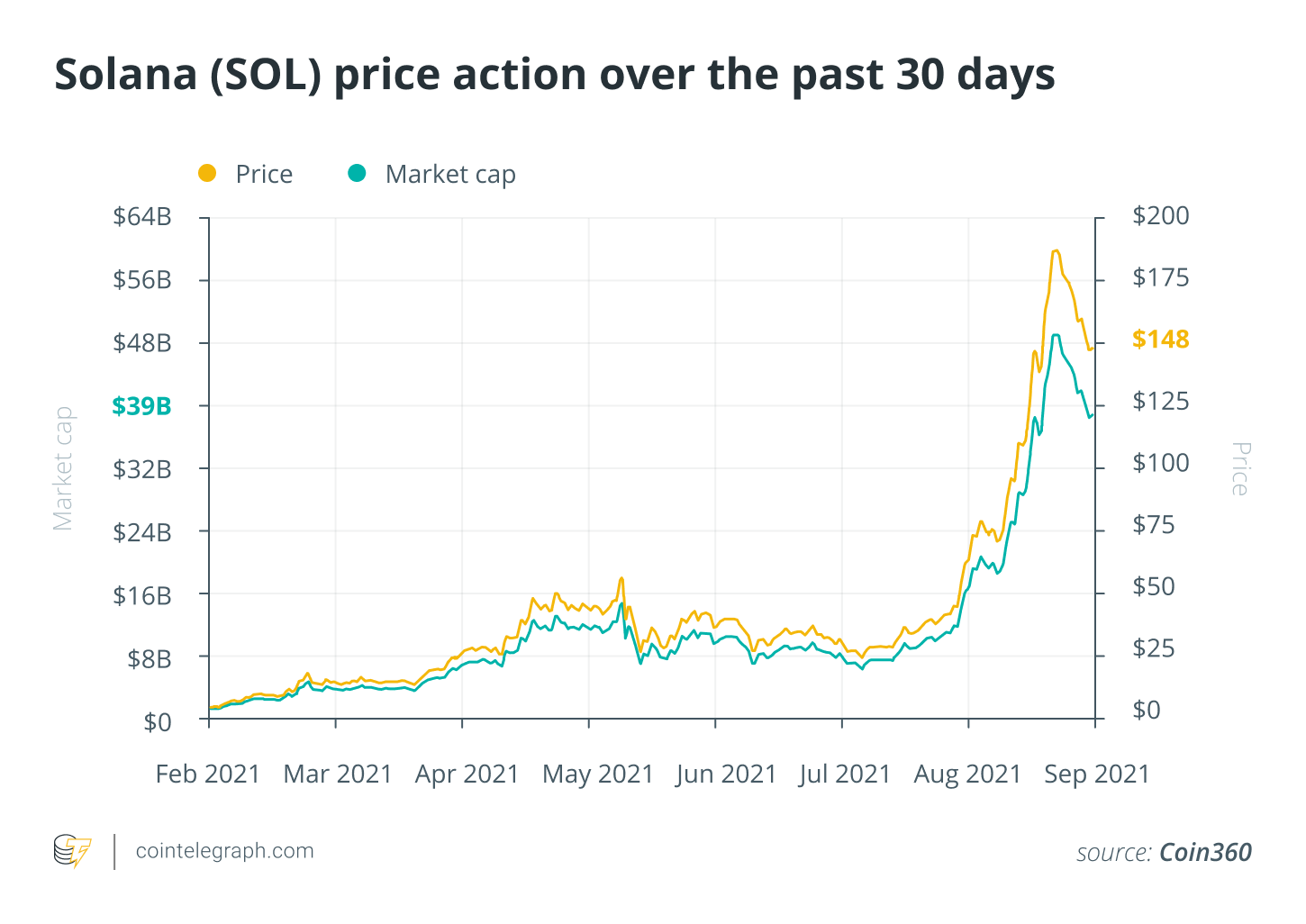The term “Ethereum killer” is beginning to pick up the pace once again in the cryptocurrency markets as the native tokens of several competing blockchain networks are posting significant gains during September. For any alternative network to be considered as a part of this category, it needs to have one essential feature that serves as the backbone of the Ethereum network: smart contracts.
Keeping this in mind, the most prominent blockchain networks by market capitalization that usually come under this purview are Cardano (ADA), Solana (SOL), Binance Smart Chain (BSC), Polkadot (DOT), and Terra(LUNA). The native tokens of these networks have been on an absolute tear this year. Most recently, Solana (SOL) has been in the spotlight after the bulls carrying its rally continued even in the face of a marketwide selloff on Sept. 8 that brought Bitcoin back below the $50,000 mark.
SOL has more than doubled in price over the last 30 days but has since declined to trade around the $155 mark. The token has posted over 300% gains over the last 90 days with an extraordinary 7,871.16% gains year-to-date (YTD). In comparison, these gains dwarf ETH’s 63.77% 90-day gains and 385.36% YTD gains. Ethereum’s market capitalization is currently at around $400 billion which is nearly 9 times SOL’s $47 billion market cap.

Ethereum killer tokens post gains
Several networks have shown promising prospects and gains. Cardano recently completed its Alonzo hard fork that launched Plutus-powered smart contracts on the network that would allow it to host decentralized finance (DeFi) and Web 3.0 applications. Even though its native token, ADA, showed a lackluster response to this milestone in the project’s roadmap, it has still experienced a substantial rise this year. ADA trades at around $2.40, posting 74.16% gains in the last 90 days and 1,273.86% gains YTD.
Marie Tatibouet, chief marketing officer at Gate.io — a cryptocurrency exchange — outlined to Cointelegraph the twofold reasons that started the Ethereum killer movement. Speaking about the network’s lack of scalability, she said, “As things stand, Ethereum is particularly slow and can only do 15-25 transactions per second with very low throughput.”
She further mentioned how high demand and low throughput lead to the next reason, bloated transaction fees that “are a bit of control.” This could go on to have an impact on the ongoing boom seen in the nonfungible token (NFT) market. She said, “Do you really want to pay half an ETH in gas fees just to mint a JPEG?”
On this, Solana Labs spokesperson told Cointelegraph, “Minting an NFT at peak levels can be very costly. Recently, a minting fee hit 3 ETH, which is more expensive than many actual NFTs. Solana offers faster speeds and lower prices than Ethereum, which is really what it comes down to with market shares.”
Another Ethereum killer prospect whose token has witnessed an outstanding performance this year is Terra. Its native token LUNA posted over 500% gains in the last 90 days and 5,477% gains YTD, and is currently trading at around $36.
Such significant gains often put a token into the spotlight due to its underlying platform and technology getting more users and increasing adoption rates. Cointelegraph spoke with Lex Sokolin, global fintech co-head and head economist at ConSensys — a blockchain technology company backing Ethereum’s infrastructure — who stated:
“DeFi protocols are applications that grow with the number of users and capital. It is likely that DeFi will be multichain and multipurpose, though the largest amount of liquidity will remain secured by Ethereum. However, expanding and incorporating other capital sources through bridges and exchanges is a net good for the ecosystem.”
Ethereum is currently in an important stage of its transformation to Ethereum 2.0 (Eth2) — an entirely proof-of-stake (PoS) blockchain after undergoing the London hard fork that brought in crucial updates like the EIP-1559 — the aftermath of which is still highly discussed in the cryptocurrency community. This Ethereum Improvement Proposal (EIP) that was agreed upon by the developers, and miners entailed a change in the transaction pricing mechanism for the network.
The change mainly impacted the inflation rate of the tokens and the miner’s revenues since a portion of gas fees are now being burned following the upgrade. According to data, over 311,300 ETH tokens have been burned, with a notional value of nearly $1.1 billion. The current burn rate is 2.7 million ETH tokens per year, which would put the inflation rate at 2.3% with the issuance of 5.3 million tokens per year.
Ethereum is not the only blockchain network to implement this kind of pricing mechanism, as Solana burns 50% of its transaction fees to regulate the supply of the SOL token. The Solana Labs spokesperson further said: “The Ethereum London upgrade changed miner incentives. Some believed that this would increase the MEV and there have been solutions launched to address this, but the cost of transactions on Ethereum continues to provide a barrier to entry.”
On-chain data says Ethereum is still king
Even though the native tokens of these “Ethereum killer” networks have posted impressive gains, a closer look at the on-chain data reveals that Ethereum’s utilization and volumes still dwarf the entirety of the remaining smart contract platform market.
Ethereum currently has a market capitalization of over $400 billion, which is significantly higher than the rest of the market. The closest network in terms of market cap is Cardano, with a $76 billion market capitalization, not even 20% as that of Ethereum.
According to data by DappRadar, the total volume locked (TVL) in DeFi protocols built on the Ethereum blockchain is just over $100 billion. In terms of utilization, the blockchain network that ranks second is the Binance Smart Chain (BSC) with a TVL of $18 billion, less than 20% of Ethereum’s TVL in DeFi.
BSC ecosystem coordinator at Binance cryptocurrency exchange Samy Karim spoke to Cointelegraph about the possibilities of Ethereum retaining its market share once the transition to Eth2 is complete:
“It has to be quick, efficient and decentralized at the same time for DeFi to attain mass adoption. Ethereum is one of the first smart contract compatible chains that can leverage its pre-existing communities to grow once Eth2 is out, but it’s next to impossible to forecast its potential market share on the basis of its probable upgrade.”
Currently, Ethereum leads the market in the NFT space as well with all the biggest NFT platforms, OpenSea, CryptoPunks, Axie Infinity, Rarible and Decentraland all being built on Ethereum. However, the whole NFT market has often been classified as a bubble by naysayers with the Chinese Communist Party becoming the latest addition when it warned the Chinese citizens about digital collectibles, and, yet, the market continues to expand.
Sokolin has voiced his disagreement on this perspective, saying: “We disagree with the categorization of the NFT ecosystem as a bubble — it is a reconfiguration of digital media structure. […] NFTs offer a different path and having a meaningful economic system is unlocking a new business model.”
However, the impact of this “bubble” even going “bust” is limited for Ethereum. In Tatibouet’s opinion, “NFTs or not, Ethereum is still the market leader when it comes to smart contract platforms. The NFT market, however, has helped the competitors in gaining an advantage over their peers.”
As Ethereum continues to build momentum toward its final transition to a PoS blockchain, the confidence that the financial markets are showing in its potential is slowly rising. A report by the British multinational bank, Standard Chartered Bank, discussed the real-world use cases of the blockchain network and accordingly valued ETH “structurally” between $26,000 and $35,000. As of now, ETH continues to show bullish trading patterns such as cup and handle and even has the prospect of hitting $6,500 in the coming few months.






